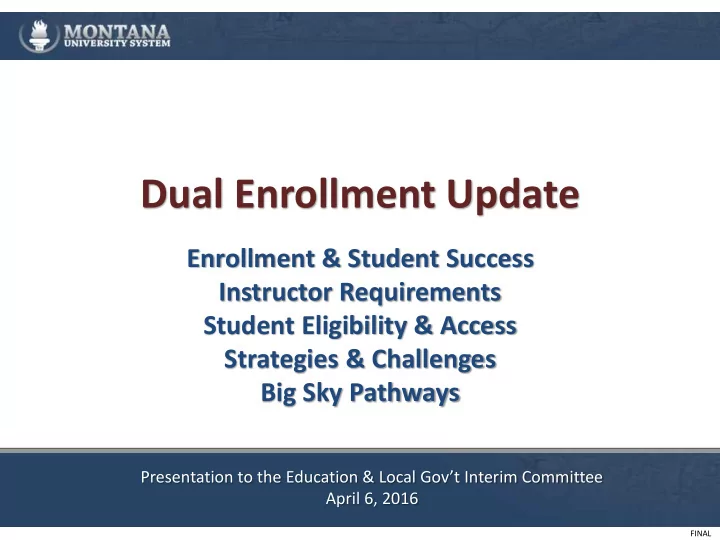

Dual Enrollment Update Enrollment & Student Success Instructor Requirements Student Eligibility & Access Strategies & Challenges Big Sky Pathways Presentation to the Education & Local Gov’t Interim Committee April 6, 2016 FINAL
Enrollment Dual Enrollment Headcount Unduplicated count of high school students enrolled in at least one college course 4,146 2500 4,013 3,197 2000 2111 2070 2035 2,535 1943 1500 1600 1597 1355 Dual Dual 1180 Dual Dual 1000 Credit Credit 1055 Credit Credit 1455 1320 1256 1260 69% 65% 65% 61% 500 0 2
Enrollment 3
Enrollment 2015-16 Stats High School Enrollment (spr 16) Average credit load = 4.4 credits Great Falls High (186) 58% female Home School (122) 84% success rate (grade = A,B,C), fall 15 Charles M. Russell (109) 45% from AA high schools Butte High (91) Bozeman (83) Most popular subjects: Columbia Falls (78) Math (15%) Writing (13%) High School Enrollment (fall 15) Statistics (5.8%) Helena High (150) Chemistry (5.3%) Sentinel High (125) Biology (5.2%) Helena Capital (108) Literature (5.2%) Hellgate High (102) History (5.2%) Butte High (100) Psychology (5.2%) Home School (94) Welding (4.6%) 4
Student Success Capture Rates 63% of high school students earning dual enrollment credit enter the MUS as college students. In comparison, approximately 40% of public high school graduates attend a MUS campus within 16 months of graduation. Student Success Compared to students who do not participate in dual enrollment, dual enrollment students outperform their peers in key success areas. 16% higher rate of first year retention (84% DE, 68% non-DE) Higher freshman GPA (3.06 DE, 2.8 non-DE) Earn more credits in first year of college. The benefits are independent of high school GPA, and often “B” and “C” students make larger gains than “A” students when compared to non-participating peers. 5
Requirements Instructor Requirements General Education course qualifications : A master’s degree with at least 9 credits in the teaching field/discipline of the dual credit class being taught. A temporary three year waiver of the nine credits can be granted if the instructor is actively pursuing the additional required credits. Career Technical Education course qualifications : three years’ experience in the occupation to be taught or an equivalent number of years of postsecondary education in the career/technical discipline, combined with work experience in the subject area of the dual credit class being taught. 6
Eligibility & Access Student Eligibility & Access ONLINE COURSES: To learn more about registering for online dual enrollment courses offered to students in all communities across the state, go to http://montanadigitalacademy.org/montana-university-system-dual-credit- information/. (View list of courses available-Fall here) ON-CAMPUS COURSES: To learn more about on-campus dual enrollment courses offered locally, contact the dual enrollment coordinator listed below at your community’s college: http://www.mus.edu/2yr/DualEnrollment.asp ELIGIBILITY: Varies by course Methods of assessment: ACT/SAT scores, placement test, Prerequisites 7
Strategies Strategies Influencing Dual Enrollment Growth 1. Common Course Numbering Guaranteed transfer of credit state-wide 2. Price Reduction Half the two-year college tuition rate, no fees ($50/cr. state average) 3. Performance-Based Funding 3 rd year of dual enrollment performance funding 4. Dual Credit Incentive Initiative – Credit for Credit (C4C) Increased pool of qualified teachers, increased knowledge of program 8
Challenges Areas of focus 1. Student affordability 2. Professional development 3. Public awareness 4. Enrollment process 5. Rural access 9
Big Sky Pathways Big Sky Pathways What is Big Sky Pathways? Gives students an early start on college and career, helps ensure a successful transition from high school to college and career. How does dual enrollment fit in Big Sky Pathways? Pathways connect a high school and college around a specific program of study. Each Pathway contains a sequence of recommended courses and/or activities to help students to best prepare for the next step, college or career. The Pathway shows the dual enrollment courses a student can take in high school, and how they fit in the college program. Big Sky Pathways is gearing up to grow CTE dual enrollment options in high schools across Montana in the coming year. 10
Big Sky Pathways 11
Big Sky Pathways Computer Technology – Associate of Applied Science 12
Big Sky Pathways Computer Technology – Associate of Applied Science 13
Big Sky Pathways Computer Technology – Associate of Applied Science 14
Big Sky Pathways Computer Technology – Associate of Applied Science 15
Big Sky Pathways Computer Technology – Associate of Applied Science 16
Recommend
More recommend